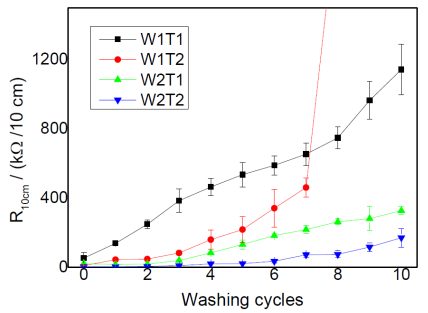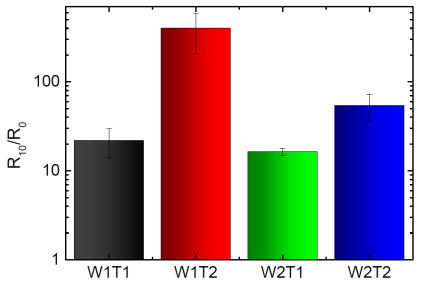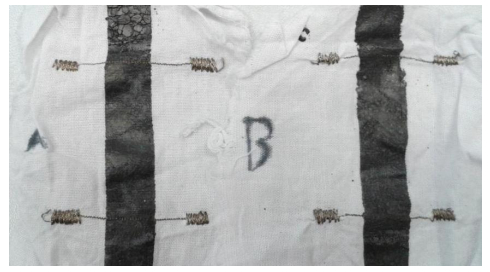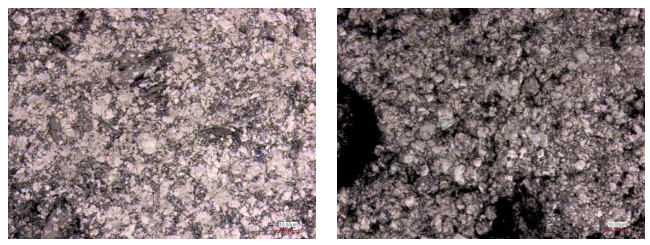1. Introduction
Polyacrylonitrile (PAN) is a typical material used in the textile industry, especially purely or in blends with natural fibers as yarn for the production of pullovers and other garments. Additionally, it is often used for electrospinning since it belongs to the few polymers which can be spun from a low-toxic solvent such as dimethyl sulfoxide (DMSO) and is nevertheless waterproof [1,2,3,4]. PAN often serves as a base for carbonization [5] and can be combined with biopolymers to tailor its morphology [6]. Nevertheless, no reports can be found in the scientific literature about using it as a base for conductive textile coatings.
Such conductive coatings are necessary for a wide range of applications, especially in electronic textiles (e-textiles). Conductive yarns or coatings are used to transport data or energy [7,8], to create textile antennas [9], to measure ECG or pulse [10,11,12,13], pressure [14] or elongation [15,16,17,18]. Unfortunately, conductive yarns or coatings are typically not washable very often without a significant loss in conductivity, either due to oxidation (in case of silver-coated yarns) or due to the heavy mechanical impact (in case of most coatings) [19]. New ideas are thus being investigated in diverse research groups. Novel conductive yarns were, e.g., produced by coating silver-covered yarns with carbon nanotubes [20], by coating PET fibers with reduced graphene oxide and silver nanoparticles [21] or by coating polyurethane yarns with graphene/poly(vinyl alcohol) layers [22]. However, such approaches usually need expensive and/or dangerous (toxic, explosive, inflammable etc.) material. Graphene, showing a very high in-plane conductivity, was also investigated for textile coatings [23,24]. Graphene coated polymeric fibers showed very high conductivities and were bendable, but washing tests were not reported [25]. Another reason why graphene is not often used for textile coatings yet is the problem to upscale the necessary processes from lab- to industrial-scale. A first attempt to create an industrial-scale process was made only recently [26].
Poly(3, 4-ethylenedioxythiophene)–poly(styrenesulfonate)(PEDOT:PSS) coatings are a possible alternative; nevertheless, this conductive polymer is known to be unstable in UV light [27,28].
Although graphite is not only conductive but also stable, inexpensive, and non-toxic, it is scarcely used to create conductive coatings [29,30]. Only few articles deal with graphite-based coatings on textile fabrics [19,29,30,31]. Especially, no approach was found in the scientific literature to combine graphite with PAN to prepare a conductive textile coating. PAN, however, has the advantage of being solvable in the low-toxic solvent DMSO, while PU—which is typically used for diverse textile coatings—always necessitates di-isocyanates as one component which are toxic and harmful to the health of the people working with it.
This is why this paper reports on first experiments as a proof-of-principle and a washing test series to enable comparison with the more often used polyurethane as matrix for a graphite coating [19]. Developing this new PAN/graphite coating further to a washing- and abrasion-resistant coating could support researchers and designers working in the broad field of smart (electronic) textiles, especially since toxic residues can be excluded and the coatings could thus be suggested for direct skin contact, like in ECG or pulse electrodes.
2. Materials and methods
Polyacrylonitrile solutions were prepared using common PAN yarn (needlework yarn "Emma") in order to avoid limiting this study to expensive PAN from specialized chemistry trade. FTIR and DSC measurements revealed that this PAN is no homo-polymer but a co-polymer; more details about the chemical structure could not be extracted from these analyses. 10 wt% PAN were dissolved in DMSO (min. 99.9%, purchased from S3 Chemicals, Germany) by stirring for two hours at room temperature and afterwards waiting for 24 hours to allow the PAN to be dissolved completely.
Graphite particles with diameters 3–5 µm were purchased from Algin (Neustadt Glewe/Germany). All coatings contained 20 wt% graphite particles, stirred with the PAN solutions for 1 h. This value resulted in resistance values in the order of 10 kΩ/(50 mm) and a reasonable viscosity for coating by a doctor blade. Here, a box-type coating bar (slit widths 60 μm and 120 μm, combined with two different coating widths) was used since coating with a revolving doctor resulted in undesired grooves which supported breaking during first tests of mechanical stress.
The cotton woven fabric used for this investigation had a thickness of 0.32 mm, areal weight of 94 g/m2, 30 warp threads per cm and 22 weft threads per cm. To avoid possible measurement deviations due to not optimal contact between the coating surface and multimeter tips, a well-known problem for conductive textile coatings, contact lines were sewn on the fabric using the conductive silver-coated yarn "Shieldex 117/17 dtex 2ply" (Statex, Bremen/Germany). It should be mentioned that this measurement method was found to be more reliable than tests with a four-point probe instrument with special electrodes for textile surfaces. This is why the resistances are given as resistance per length, not as sheet resistances. In addition, these values can be compared easier to the results of a previous experiment with graphite/PU coatings [19].
Samples were prepared using a distance of 50 mm between these contact lines, coating widths of 15 mm (samples "W1") and 75 mm (samples "W2") combined with wet film thicknesses of 60 μm (samples "T1") and 120 μm (samples "T2"). For all four combinations, 3 samples were prepared.
Washing tests were performed using a household washing machine Miele Primavera with heavy duty detergent at 40 ℃ and spin cycling with 1400 min−1. 10 washing cycles were performed during this study.
For resistance measurements, a Mastech PM334 digital multimeter was used with a maximum measurable resistance of 30 MΩ, connected to the conduction lines with crocodile clamps. Measurements were performed 5 times per sample, taking off the crocodile clamps from the contact yarn and clamping it again after a few seconds to avoid possible problems due to insufficient contacts.
Microscopic images of the coating surfaces were taken using a confocal laser scanning microscope (CLSM) VK-9700 by Keyence, using a nominal magnification of 2000×.
3. Results and discussion
Figure 1 depicts two of the samples W1T2 (lower widths, higher thickness) with the sewn contact lines before washing. It can be recognized that the contact lines are visibly higher than the surrounding cotton fabric which may cause problems during washing tests; however, in the test series performed in this study, breaking of the coating did not appear significantly more often along these sewing lines than in other areas.
The results of the washing tests are depicted in Figure 2. All samples start at similar resistance values of approx. 4–10 kΩ/(10 cm) in case of the thicker lines (W1T2 and W2T2) and 20–50 kΩ/(10 cm) in case of the thinner coatings (W1T1 and W2T1), respectively. These values are comparable to the resistances reached with a commercial silicone rubber coating on cotton and also comparable with most graphite/PU coatings on cotton, created with an equivalent technology [19]. Especially for the main aim of this study to develop new materials for textile-based ECG electrodes, such conductivities are absolutely sufficient [32]. On the other hand, applications for heating also necessitate such relatively high resistances.
Comparing the developments during the washing tests, it is obvious that the wider coatings (W2) show smaller resistances than the narrower ones, and the thicker coatings (T2) have generally lower resistance values than the thinner ones. On the other hand, it should be mentioned that all thicker samples with lower width (W1T2) broke severely after 8 washing cycles, resulting in a significantly increased resistance.
Breaking along creases could be avoided by using thinner or broader coatings; however, this behavior shows that the coating is not yet ideally suited for application on textile fabrics. A typical method used to make textile coatings softer and reduce breaking is the addition of silicone; however, a recent study of polyurethane/graphite coatings with silicone on different textile fabrics has shown a similar resistance increase during washing [19]. Preliminary tests with silicone added to PAN/graphite coatings resulted in significantly softer and better bendable coatings. While breaking of these coatings during washing was strongly reduced, sometimes delamination of the coating from the textile fabric could be observed, most probably since the more elastic coating could bend more during washing and thus stronger in-plane forces worked on separating both materials. These findings show that more research is necessary to develop this new coating further and to increase not only washing fastness but also the adhesion on textile fabrics, e.g., by a plasma-pretreatment which is often used in the textile industry.
Comparing the relative resistance increases of the four sets of samples (Figure 3) shows the following results: Samples with thicker coatings (T2) have a higher relative increase of the resistance than thinner coated samples; and samples with larger width (W2) show a tendency of lower resistance increase. This is another hint that breaking of the coatings along creases—which can be expected to happen easier in thicker coatings and to have lower impact in broader coatings where small areas can be lost without completely losing the contact—is the main reason for the severe resistance increase due to washing.
Figure 4 depicts macroscopic photographs of the same samples as shown in Figure 1, taken after 10 washing cycles. In some areas—especially above the upper contact line of sample "A" where the coating thickness is higher than in the middle part between both contact lines—cracks in the coating are clearly visible. However, even in the area between both connection lines, breaks in the coating can be recognized.
It should be mentioned that the contact between the Statex yarn and the crocodile clamps stayed approximately constant over the washing cycles, as could easily be measured by contacting one line with both clamps.
Interestingly, test measurements with crocodile clamps directly contacting the coating resulted in ambiguous resistances—independent of the sample type under investigation, partly similar resistances were measured as with the contact lines, while other areas of the coating showed significantly higher contact resistances. This is why the surface of the coatings was investigated more in detail.
Figure 5 depicts CLSM images, taken on W1T2 samples directly after coating and after 10 washing cycles (images taken on the other sets of samples showed equal results). Firstly, it can be recognized that the image before washing is brighter, suggesting that the graphite flakes are more oriented parallel to the surface, thus reflecting more light, while the surface is more disturbed after the washing test. Additionally, deep creases are visible after washing. This effect occurs nearly everywhere on the surface of these samples, clearly showing that breaking of the coating is a severe problem which has to be faced in the next text series.
4. Conclusions
To conclude, we have investigated the possibility to create conductive coatings using graphite-filled polyacrylonitrile. Direct comparison with a similar test series on the identical textile fabric using polyurethane instead of PAN shows similar resistances before and after washing for both polymers, with PAN having the advantage of not necessitating toxic precursors. Nevertheless, the washing fastness must be increased. These results indicate that further research should be performed, testing different PAN/graphite ratios as well as the addition of silicone or other softeners, on a variety of textile fabrics.
Conflict of interest
All authors declare no conflicts of interest in this paper.









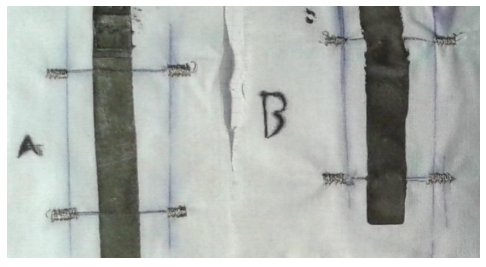
 DownLoad:
DownLoad: 